It looks like you're using an Ad Blocker.
Please white-list or disable AboveTopSecret.com in your ad-blocking tool.
Thank you.
Some features of ATS will be disabled while you continue to use an ad-blocker.
share:
Originally posted by nablator
reply to post by Europa733
What's bothering me is the predominant blue channel. Why is it so blue? Is it a blue bird? Or a huge mothership very far away? Very puzzling.
Hi there,
Most photographers I 've been talking to about this photo tell me the same
thing, the predominant blue is caused by distance (air humidity absorbtion), speed (object catching part of the sky behind him) and by the lens being almost pointed towards the Sun.
So, most of them say that it isn't close and most probably behind the church
at quiet a distance and on top of all, going fast.
Peace,
Europa aka Buckwild aka The ever unsatisfied
Hi Europa.
Yup, You'll notice that i mentioned that on page 2 post 7 or something.
One optical possibility is that you have a neutrally gray object being filtered through atmospheric haze.
With the atmosphere in this case acting as a blue filter.
The problem being here that the red and green channels are not just reduced but are effectively missing and one of my previous images show you atmospheric haze (nasty air through a large city in my own case)..about a mile of it in the case of the aeroplane.
That and there is still that shadow to account for...
Yup, You'll notice that i mentioned that on page 2 post 7 or something.
One optical possibility is that you have a neutrally gray object being filtered through atmospheric haze.
With the atmosphere in this case acting as a blue filter.
The problem being here that the red and green channels are not just reduced but are effectively missing and one of my previous images show you atmospheric haze (nasty air through a large city in my own case)..about a mile of it in the case of the aeroplane.
That and there is still that shadow to account for...
I agree it mainly exists in the blue however I want to add my own speculation based off of the CYMK analysis that this guy likes to hang out in the
ultra violet area. The relative shadow of the object seems to be in the red spectrum and by pumping up the C & Y 200% then turning up the red to add
more shadow you come up with more definition:
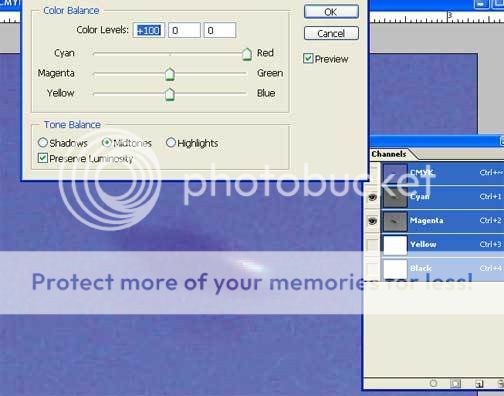

No you can see I was working on amplifying the color channels in particular and even while trying to enhance anything out of the black or yellow channel I got nothing:

So let's zoom back and look at that again:
Cyan & Magenta:

Yellow & black:
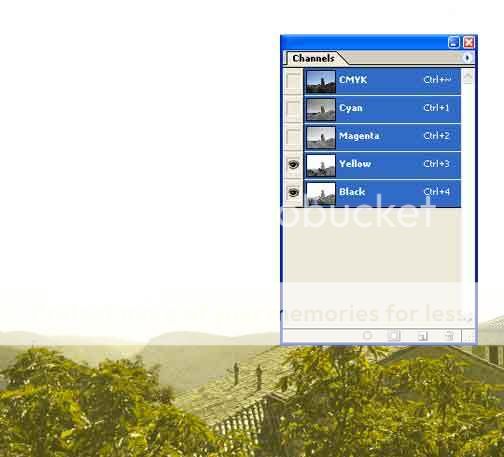
Now I wonder...would the birdies show up in all spectrums, I believe so. Let's take a look shall we?
Birdy from the same pic in Black:
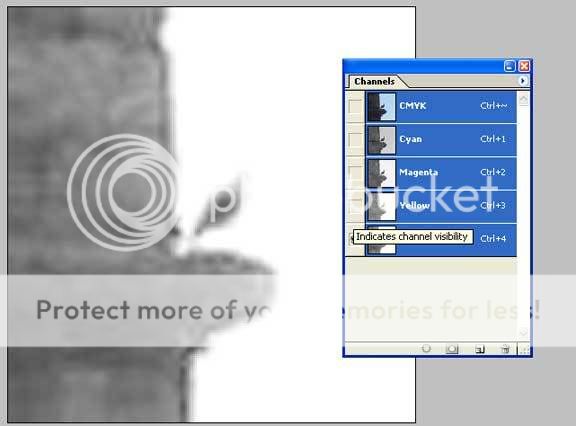
Birdy from the same pic in Yellow:
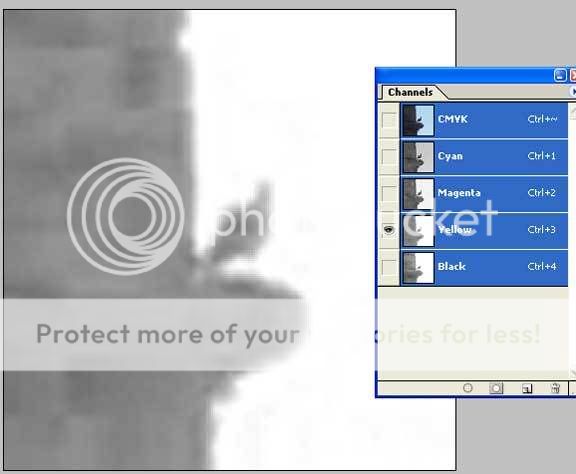
Birdy from the same pic with both Y&K channels on:

As far as the shadow goes, I an see why the elongated one is there, but the pyramid (which actually seems to be more of a cone), I have no idea. Maybe if it was spinning that would create a vortex like planes going through the clouds, but I don't know how I would be able to get that kind of info from the pic off the top of my head:



No you can see I was working on amplifying the color channels in particular and even while trying to enhance anything out of the black or yellow channel I got nothing:

So let's zoom back and look at that again:
Cyan & Magenta:

Yellow & black:

Now I wonder...would the birdies show up in all spectrums, I believe so. Let's take a look shall we?
Birdy from the same pic in Black:

Birdy from the same pic in Yellow:

Birdy from the same pic with both Y&K channels on:

As far as the shadow goes, I an see why the elongated one is there, but the pyramid (which actually seems to be more of a cone), I have no idea. Maybe if it was spinning that would create a vortex like planes going through the clouds, but I don't know how I would be able to get that kind of info from the pic off the top of my head:

reply to post by Shakesbeer
Hi there,
Thanks for doing this, but question is, since the bird is contrasted to start with, is it very relevant to compare them ?
Can you do the same test with a blurry grey plane seen form far with blue skies with a little haze, just a bit ?
Peace,
Europa
[edit on 9-3-2008 by Europa733]
Hi there,
Thanks for doing this, but question is, since the bird is contrasted to start with, is it very relevant to compare them ?
Can you do the same test with a blurry grey plane seen form far with blue skies with a little haze, just a bit ?
Peace,
Europa
[edit on 9-3-2008 by Europa733]
Hi Europa.
Yes you can in terms of the contrast comparison, after all solid shadows are solid shadows and really are an absence of color in all channels.
Feel free to grab any of my images and try it.
Sorry, i'd thought I had already emphasised the fact that 'ALL' of the out of focus images i had provided were capable of displaying even color channel information with a little discrepancy in each. The aeroplane was merely a good example.
If you want i can grab some more tomorrow and post channel info for new ones...(shouldnt be that hard to get)
Absence.
Yes you can in terms of the contrast comparison, after all solid shadows are solid shadows and really are an absence of color in all channels.
Feel free to grab any of my images and try it.
Sorry, i'd thought I had already emphasised the fact that 'ALL' of the out of focus images i had provided were capable of displaying even color channel information with a little discrepancy in each. The aeroplane was merely a good example.
If you want i can grab some more tomorrow and post channel info for new ones...(shouldnt be that hard to get)
Absence.
reply to post by Absence of Self
Hi again,
you so much, please go ahead.
Now this part is for PSR radar experts :
Forward to 7 mn :
www.dailymotion.com...
Check the simulation done regarding the "ghost" radar return, we're talking
about a 20 seconds long event, with speed changes.
Is it unusual to get this kinds of radar returns ?
Peace,
Europa
[edit on 9-3-2008 by Europa733]
Hi again,
you so much, please go ahead.
Now this part is for PSR radar experts :
Forward to 7 mn :
www.dailymotion.com...
Check the simulation done regarding the "ghost" radar return, we're talking
about a 20 seconds long event, with speed changes.
Is it unusual to get this kinds of radar returns ?
Peace,
Europa
[edit on 9-3-2008 by Europa733]
Hi everyone,
There it goes within the yellow channel :
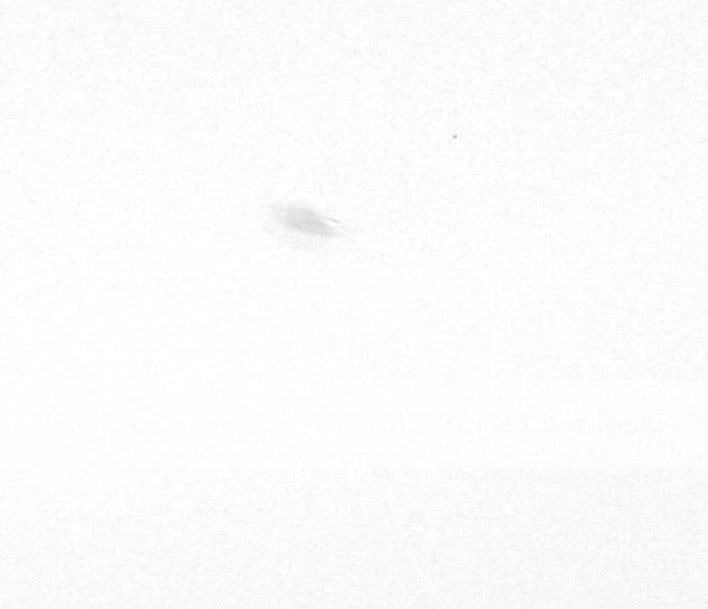
My friend tells me that the black channel test is useless.
Since we're not talking about emission lines it cannot be a spectral analysis.
And since X is under exposed it is impossible to know it's composition.
Peace,
Europa
[edit on 9-3-2008 by Europa733]
There it goes within the yellow channel :

My friend tells me that the black channel test is useless.
Since we're not talking about emission lines it cannot be a spectral analysis.
And since X is under exposed it is impossible to know it's composition.
Peace,
Europa
[edit on 9-3-2008 by Europa733]
Originally posted by Europa733
Thanks for doing this, but question is, since the bird is contrasted to start with, is it very relevant to compare them ?
Can you do the same test with a blurry grey plane seen form far with blue skies with a little haze, just a bit ?
[edit on 9-3-2008 by Europa733]
Good question and the main purpose of posting the bird examples was to illustrate more clearly what Absence and myself have been talking about. I used the bird in the picture just so that I could confirm that this wasn't a picture of a the indigenous French Chameleon-Pigeon or anything like that at the same time. And of course because it is a picture of a bird from the same source, so why not? But if something is moving fast enough and/or out of focused you could duplicate this naturally. However, in this particular image, there seems to be absolutely no black information in that area at all. I used Absence of Self's example taking what I thought was the most out of focus and "cloud-like" picture, and we know the bird was moving too:

Here is the results of bumping up the contrast/brightness to review as much as I could in the black channel:

Like I was saying; one peculiar thing about the ufo image is that there appears to be absolutely no information in the black at all in that region, despite the fact we have been able to coax out fairly sharp edges and contrast from the object. I was hoping there would too, because that would have allowed me to pull up more detail, be it a bird, experimental jet, or fun-loving aliens:

Originally posted by Europa733
My friend tells me that the black channel test is useless.
Since we're not talking about emission lines it cannot be a spectral analysis.
And since X is under exposed it is impossible to know it's composition.
[edit on 9-3-2008 by Europa733]
That doesn't make any sense, we're not trying to determine an element based on the spectrograph....unless that's what you where going to try which is a cool idea.
What I'm talking about has more to do with digital cameras being able to get further into the Infrared spectrum then the human eye, as well as being "quicker" sometimes.
[edit on 9-3-2008 by Shakesbeer]
Hi Europa.
First off.
No no no no no no...etc.
Dont mistake a compound analysis and triangular calculation of the image from its basic components.
Those are completly separate things.
Remember its not a 'channel' test.
Its a straight unprocessed channel dump from the original jpg, there is no testing there.
We are using its original color space with no conversion. (srgb)
The channel information is simply absent...
Blue = Fine
Green = Not so fine.
Red = Gone.
Remember, Bayer arrays (CCD sensors) don't have yellow. Only R.G.B.
*Edit...
Kudos Shakesbeer.
Lots faster than me....you get a 'happy star'.
[edit on 9-3-2008 by Absence of Self]
First off.
No no no no no no...etc.
Dont mistake a compound analysis and triangular calculation of the image from its basic components.
Those are completly separate things.
Remember its not a 'channel' test.
Its a straight unprocessed channel dump from the original jpg, there is no testing there.
We are using its original color space with no conversion. (srgb)
The channel information is simply absent...
Blue = Fine
Green = Not so fine.
Red = Gone.
Remember, Bayer arrays (CCD sensors) don't have yellow. Only R.G.B.
*Edit...
Kudos Shakesbeer.
Lots faster than me....you get a 'happy star'.
[edit on 9-3-2008 by Absence of Self]
P.s.
We really dont have any possibility of performing a spectro analysis on it.
Spectro means we need the separation of wavelengths from the subject image before its hits the sensor.
Especially since when it does hit the sensor its effectively summated and there is no possibility of wavelength separation.
There is a possibility that it could be done but you'd need a sacrifical camera since we would have to modify both the near IR filter of the sensor (i.e. Bin it) and introduce a grating filter between the lens and sensor...its an expensive experiment.
Its a fascinating subject by the way.
If you want more information on spectro using normal SLR cameras check this out...
Christian Buil
*typos
[edit on 9-3-2008 by Absence of Self]
We really dont have any possibility of performing a spectro analysis on it.
Spectro means we need the separation of wavelengths from the subject image before its hits the sensor.
Especially since when it does hit the sensor its effectively summated and there is no possibility of wavelength separation.
There is a possibility that it could be done but you'd need a sacrifical camera since we would have to modify both the near IR filter of the sensor (i.e. Bin it) and introduce a grating filter between the lens and sensor...its an expensive experiment.
Its a fascinating subject by the way.
If you want more information on spectro using normal SLR cameras check this out...
Christian Buil
*typos
[edit on 9-3-2008 by Absence of Self]
reply to post by Absence of Self
Hi again,
Thanks for your explanation and link.
By the way, I did open a topic about that : www.belowtopsecret.com...
My question is, since X is absorbed by the atmosphere (distance) +
it's probably moving fast, isn't it normal to see nothing within the red channel ?
Peace,
Europa
Hi again,
Thanks for your explanation and link.
By the way, I did open a topic about that : www.belowtopsecret.com...
My question is, since X is absorbed by the atmosphere (distance) +
it's probably moving fast, isn't it normal to see nothing within the red channel ?
Peace,
Europa
reply to post by Europa733
Not really, though you would need to bear in mind my knowledge of dopplar wave shifting is in the fundamentals only.
(I'm supposed to be catching up on that this week. time permitting)
Motion and your ability to detect it depends on your exposure time and the angular fov so long as the angle of motion is parallel to your own viewpoint (of which you really need both). Otherwise you end you with best guess inaccuracies.
We had nothing to work with within a concrete sense since the original image was only exposed for 1/400th of a second and distances involved are alot less than would be detectable by photospectrophic phasing (red shift).
For an object to be capable of shifting itself in its entirety into the 'blue' spectra you would have a real problem since it would need to be accelerating towards your perspective at a rate where wave compression would be possible.
After all, thats what red/blue wave shift actually is*. Light wave compression/Expansion dependant on velocity with respect to the observer.
(*yes... it's for want of a better term total horse s**t, red shift and blue shift is impossible given the quantum nature of light and its zero potential rest energy but there you go...)
Not really, though you would need to bear in mind my knowledge of dopplar wave shifting is in the fundamentals only.
(I'm supposed to be catching up on that this week. time permitting)
Motion and your ability to detect it depends on your exposure time and the angular fov so long as the angle of motion is parallel to your own viewpoint (of which you really need both). Otherwise you end you with best guess inaccuracies.
We had nothing to work with within a concrete sense since the original image was only exposed for 1/400th of a second and distances involved are alot less than would be detectable by photospectrophic phasing (red shift).
For an object to be capable of shifting itself in its entirety into the 'blue' spectra you would have a real problem since it would need to be accelerating towards your perspective at a rate where wave compression would be possible.
After all, thats what red/blue wave shift actually is*. Light wave compression/Expansion dependant on velocity with respect to the observer.
(*yes... it's for want of a better term total horse s**t, red shift and blue shift is impossible given the quantum nature of light and its zero potential rest energy but there you go...)
-does the I got a "happy star" dance-
Thank you much
At this point I have to say I'm leaning towards this being a saucer. The only reason I say it's a saucer is because that's what it looks like...and the analysis helps I guess
Thank you much
At this point I have to say I'm leaning towards this being a saucer. The only reason I say it's a saucer is because that's what it looks like...and the analysis helps I guess
Hi,
Chinese lantern (white) "test" at sunset (with more contrast)
RGB :

Red channel :

Blue disappear as it is sunset while the other one's (UFO pic) got almost clear blue skies late in the morning, so lots more towards the blue.
So, let's say it's a metallic object that reflects the blue so within the red channel the blue part disappears.
What about the green channel ?
Well since blue is the picture's dominant channel : green = yellow + blue
then you only see what is blue.
What do you think, sounds logical, doesn't it ?
Peace,
Europa
EDIT : I'll give a star to both of you guys for your time spent and help. Good night it's getting late here ...
[edit on 9-3-2008 by Europa733]
[edit on 9-3-2008 by Europa733]
Chinese lantern (white) "test" at sunset (with more contrast)
RGB :

Red channel :

Blue disappear as it is sunset while the other one's (UFO pic) got almost clear blue skies late in the morning, so lots more towards the blue.
So, let's say it's a metallic object that reflects the blue so within the red channel the blue part disappears.
What about the green channel ?
Well since blue is the picture's dominant channel : green = yellow + blue
then you only see what is blue.
What do you think, sounds logical, doesn't it ?
Peace,
Europa
EDIT : I'll give a star to both of you guys for your time spent and help. Good night it's getting late here ...
[edit on 9-3-2008 by Europa733]
[edit on 9-3-2008 by Europa733]
Originally posted by Europa733
What about the green channel ?
Well since blue is the picture's dominant channel : green = yellow + blue
then you only see what is blue.
What do you think, sounds logical, doesn't it ?
That's sort of where I worked up from to get that last "enhanced" version I did that looked like it was later in the day. Instead of having the blue be the dominate tone, I attempted to neutralize it relative to the object. The green channel was essentially the "object" layer, and the blue and red where to balance out light & shadow.
Speaking CYMK, here's the lantern with an easy to pull up black channel:

Originally posted by internos
Originally posted by Shakesbeer
reply to post by internos
Dude seriously a bird? I've taken pics of birds in flight on purpose and that's a stretch, especially considering size relation and position of the object(appears to be behind the tower) to the bird in the front. Neat gif though
Yes, seriously a bird, very seriously.
Pheraps you need to take some more pictures of birds.
But i'd be interested in HOW can you guess about the distance from the camera of an object when you talk about a 2D image showing different objects that are being hit in different ways by the sunlight: whow, much interested. Did you make a triangulation, pheraps? Do you have some more pictures of the same object taken from different angles?
If yes, then you're right, if not, then you're wrong, "Dude" .
[edit on 8/3/2008 by internos]
I had some cases with birds diving in the shot, and I always see them swooshing by and curse (because it mostly ruins your picture).
I do not know what this is, could be both, but my guess is that if you don't see it when taking the picture, you are slow yourself ;-). After diving there is a moment of slowing down that makes it exceptionally visual, often in the periphery of your eye (that is , the eye that is not watching through the camera. When you are watching on a little sreen this is even more the case)
Been testing image a bit, mostly to see what it leads to....
Well i've found something that stands out (as have others here) in that picture.
First we have the object itself:
Here we can clearly see the triangular shadow caused by this object.
We also see a typical "saucer" shape to it.
Now we have a seccond anomaly in this view.
The "blue dot"
I belive this to be a close object, a bug or similar.
But as i am not an expert on these things....
But could a fast spinning object cause electromagnetic curves to show on an image?
Anyways i dont think it is as bird
Well i've found something that stands out (as have others here) in that picture.
First we have the object itself:
Here we can clearly see the triangular shadow caused by this object.
We also see a typical "saucer" shape to it.
Now we have a seccond anomaly in this view.
The "blue dot"
I belive this to be a close object, a bug or similar.
But as i am not an expert on these things....
But could a fast spinning object cause electromagnetic curves to show on an image?
Anyways i dont think it is as bird
Originally posted by Europa733
Originally posted by Shakesbeer
One thing that does still strike me as very peculiar though is the shadow. Why is it showing up as a triangle? The peak seems to stick out above the object which would not coincide with the angle of the sun, be it a bird of a probe-lovin' alien At the same time I see absolutely no digital signature on the original jpeg that would lead me to believe any of this was added later.
Hi there,
One of my "theories" is that X could be a triangle spinning on it's axis
at a very fast rate.
Just my two cents...
Peace,
Europa
Spot on, well the triangle collection of electrical charges.
The central location emits 'ropes' of electron streams, this was
given by Tesla in one of his speeches to common unknowing
press and in his one wire bulb experiments.
The UFO is a kind of Faraday or Tesla bulb.
The craft bottom has a collection of positive ions.
This shields the UFO from the momentum of the Cosmos, ether or
'dark matter', and is free to move.
A SiFi explanation isn't it.
ED: Electrons might show up as green, positive ions as red...is this
what you see?
[edit on 3/10/2008 by TeslaandLyne]
new topics
-
Remember These Attacks When President Trump 2.0 Vengeance-Retribution Commences.
2024 Elections: 21 minutes ago -
Predicting The Future: The Satanic Temple v. Florida
Conspiracies in Religions: 29 minutes ago -
WF Killer Patents & Secret Science Vol. 1 | Free Energy & Anti-Gravity Cover-Ups
General Conspiracies: 2 hours ago -
Hurt my hip; should I go see a Doctor
General Chit Chat: 3 hours ago -
Israel attacking Iran again.
Middle East Issues: 4 hours ago -
Michigan school district cancels lesson on gender identity and pronouns after backlash
Education and Media: 4 hours ago -
When an Angel gets his or her wings
Religion, Faith, And Theology: 5 hours ago -
Comparing the theology of Paul and Hebrews
Religion, Faith, And Theology: 6 hours ago -
Pentagon acknowledges secret UFO project, the Kona Blue program | Vargas Reports
Aliens and UFOs: 7 hours ago -
Boston Dynamics say Farewell to Atlas
Science & Technology: 7 hours ago
top topics
-
The Democrats Take Control the House - Look what happened while you were sleeping
US Political Madness: 10 hours ago, 18 flags -
In an Historic First, In N Out Burger Permanently Closes a Location
Mainstream News: 12 hours ago, 16 flags -
Biden says little kids flip him the bird all the time.
Politicians & People: 10 hours ago, 9 flags -
Man sets himself on fire outside Donald Trump trial
Mainstream News: 9 hours ago, 9 flags -
Michigan school district cancels lesson on gender identity and pronouns after backlash
Education and Media: 4 hours ago, 7 flags -
WF Killer Patents & Secret Science Vol. 1 | Free Energy & Anti-Gravity Cover-Ups
General Conspiracies: 2 hours ago, 6 flags -
Pentagon acknowledges secret UFO project, the Kona Blue program | Vargas Reports
Aliens and UFOs: 7 hours ago, 6 flags -
Israel attacking Iran again.
Middle East Issues: 4 hours ago, 5 flags -
Boston Dynamics say Farewell to Atlas
Science & Technology: 7 hours ago, 4 flags -
Remember These Attacks When President Trump 2.0 Vengeance-Retribution Commences.
2024 Elections: 21 minutes ago, 3 flags
active topics
-
Israel attacking Iran again.
Middle East Issues • 28 • : KrustyKrab -
Predicting The Future: The Satanic Temple v. Florida
Conspiracies in Religions • 4 • : Sookiechacha -
In an Historic First, In N Out Burger Permanently Closes a Location
Mainstream News • 11 • : TheMisguidedAngel -
Remember These Attacks When President Trump 2.0 Vengeance-Retribution Commences.
2024 Elections • 3 • : KrustyKrab -
Michigan school district cancels lesson on gender identity and pronouns after backlash
Education and Media • 9 • : TheMisguidedAngel -
Mood Music Part VI
Music • 3064 • : MRTrismegistus -
Man sets himself on fire outside Donald Trump trial
Mainstream News • 41 • : TheMisguidedAngel -
The New, New ATS Members Photos thread. Part 3.
Members • 1653 • : zosimov -
A man of the people
Medical Issues & Conspiracies • 15 • : PrivateAngel -
I hate dreaming
Rant • 7 • : TheMichiganSwampBuck

